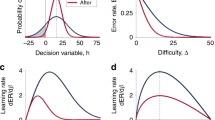Abstract
A rational theory of discrimination learning is developed for the special case in which the subject must discriminate between two stimuli which differ with respect to one variable such as size or brightness. It is shown that the previous equations developed by Gulliksen and Thurstone are special cases of the present one. It is predicted that the ultimate level of accuracy of the discrimination is inversely related to the difference, as determined psychophysically, between the two stimuli. Other implications of the theory for experimental work are presented.
Similar content being viewed by others
References
Bass, M. J., andHull, C. L., “The irradiation of a tactile conditioned reflex in man,”Jour. Comp. Psychol., 1934,17, 47–65.
Fields, P. E., “Studies in concept formation: II. A new multiple stimulus jumping apparatus for visual figure discrimination,”Jour. Comp. Psychol., 1935,20, 183–203.
Gulliksen, H., “Studies of transfer of response: I. Relative versus absolute factors in the discrimination of size by the white rat,”Ped. Sem. and Jour. Genet Psychol., 1932,40, 37–51.
Gulliksen, H., “A rational equation of the learning curve based on Thorndike's Law of Effect,”Jour. Gen. Psychol., 1934,11, 395–434.
Gulliksen, H., “The relationship between degree of original learning and degree of transfer,”Psychometrika, 1936,1, 37–43.
Hebb, D. O., “The innate organization of visual activity: II. Transfer of response in the discrimination of brightness and size by rats reared in total darkness,”Jour. Comp. Psychol., 1937,24, 277–299.
Hebb, D. O., “Innate organization of visual activity: III. Discrimination of brightness after removal of the striate cortex in the rat,”Jour. Comp. Psychol., 1938,25, 427–437.
Helsen, H., “Insight in the white rat,”Jour. Exper. Psychol., 1937,10, 378–396.
Hovland, C. I, “The generalization of conditioned responses: I. The sensory generalization of conditioned responses with varying frequencies of tone,”Jour. Gen. Psychol., 1937,17, 125–148.
Hovland, C. I., “The generalization of conditioned responses: IV. The effects of varying amounts of reinforcement upon the degree of generalization of conditioned responses,”Jour. Exper. Psychol., 1937,21, 261–276.
Hull, C. L., “The conflicting psychologies of learning—A way out,”Psychol. Rev., 1935,42, 491–516.
Hull, C. L., “Mind, mechanism, and adaptive behavior,”Psychol. Rev., 1937,44, 1–32.
H(ull), C. L., “Some tentative theorems concerning stimulus equivalence. (Memorandum to Mr. Hull's graduate seminar),” Mimeographed, Feb. 14, 1938, pp. 10.
Köhler, W.,Gestalt Psychology. New York: Liveright, 1929, x + 403.
Krechevsky, I., “‘Hypotheses’ vs. ‘chance’ in the pre-solution period in sensory discrimination-learning,”Univ. Calif. Publ. Psychol., 1932,6: No. 3, 27–44
Krechevsky, I., “A study of the continuity of the problem-solving process,”Psychol. Rev., 193845, 107–133.
Lashley, K. S.,Brain mechanisms and intelligence, Chicago: University of Chicago Press, 1929, xiv + 186 + 11 plates.
Lashley, K. S., “The mechanism of vision: I. A method for rapid analysis of pattern-vision in the rat,”Jour. Genet. Psychol., 1930,37, 453–460.
Lashley, K. S., “The mechanism of vision: XV. Preliminary studies of the rat's capacity for detail vision,”Jour. Gen. Psychol., 1938,18, 123–193.
Moulton, F. R.,Differential Equations. New York: Macmillan, 1930, xv + 395.
Munn, N. L., “An apparatus for testing visual discrimination in animals,”Jour. Genet. Psychol., 1931,39, 342–358.
Perkins, F. T., andWheeler, R. H., “Configurational learning in the goldfish,”Comp. Psychol. Monog., 1930,7: No. 31, pp.50.
Rashevsky, N.,Mathematical Biophysics, Chicago: University of Chicago Press, 1938, xviii + 340.
Révész, G., “Experimental study in abstraction in monkeys,”Jour. Comp. Psychol., 1925,5, 293–343.
Spence, K. W., “The nature of discrimination learning in animals,”Psychol. Rev., 1936,43, 427–449.
Spence, K. W., “The differential response in animals to stimuli varying within a single dimension,”Psychol. Rev., 1937,44, 430–444.
Thorndike, E. L.,The fundamentals of learning, New York: Teacher's College, Columbia Univ., Bur. Publ., 1932, xvii + 638.
Thurstone, L. L., “The learning function,”Jour. Gen. Psychol., 1930,3, 469–493.
Thurstone, L. L., “The error function in maze learning,”Jour. Gen. Psychol., 1933,9, 288–301.
Warden, C. J., andRowley, J. B., “The discrimination of absolute versus relative brightness in the ring dove,Turtur risorius,”Jour. Comp. Psychol., 1929,9, 317–337.
Warden, C. J., andWinslow, C. N., “The discrimination of absolute versus relative size in the ring dove,Turtur risorius,”Jour. Genet. Psychol., 1931,39, 328–341.
Wiley, L. E., andWiley, A. M., “Studies in the learning function,”Psychometrika, 1937,2, 1–19, 107–120, 161–164.
Wolfle, D. L., “Absolute brightness discrimination in the white rat,”Jour. Comp. Psychol., 1937,24, 59–71.
Yerkes, R. M., andWatson, J. B., “Methods of studying vision in animals,”Behavior Monographs, 1911,1: No. 2, pp. iv + 90.
Young, G., andHouseholder, A. S., “Discussion of a set of points in terms of their mutual distances,”Psychometrika, 1938,3, 19–22.
Author information
Authors and Affiliations
Additional information
We are grateful to the members of Professor Thurstone's Seminar in Mathematical Psychology for criticism of this paper and particularly to Mr. John Reiner for assistance in the derivations involved.
Rights and permissions
About this article
Cite this article
Gulliksen, H., Wolfle, D.L. A theory of learning and transfer: I. Psychometrika 3, 127–149 (1938). https://doi.org/10.1007/BF02288482
Issue Date:
DOI: https://doi.org/10.1007/BF02288482




